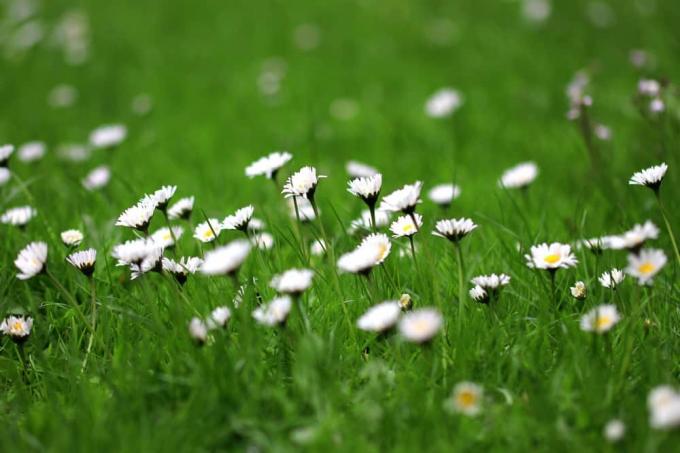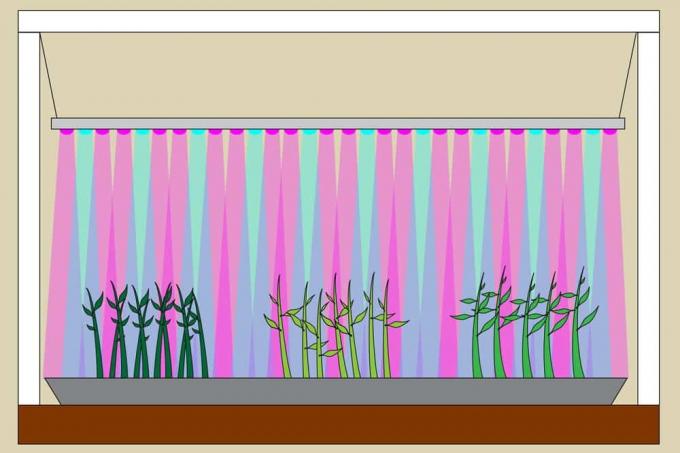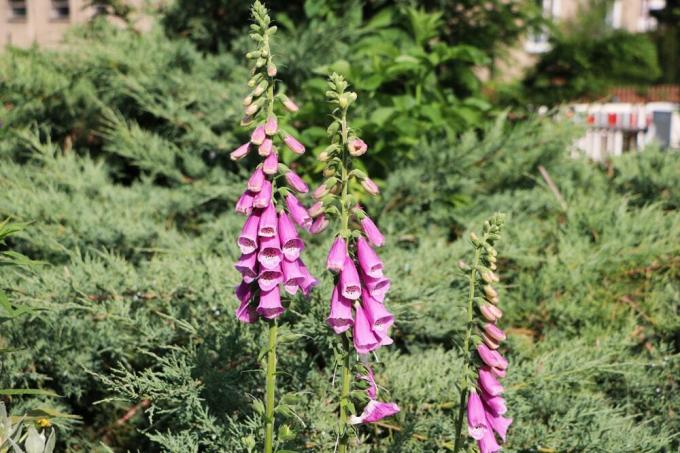

Table of contents
- Optimal planting time
- prepare ground
- Care
- Rustic cottage garden
- This is what summer smells like
- Cut perennials for the vase
- The rock garden
- frequently asked Questions
- Worth knowing about bedding plants shortly
The selection of wild perennials for the garden is of particular importance. The garden perennials known today were created through further breeding. In most cases, they surpass their wild relatives in terms of stability, robustness, longevity and willingness to flower. The expression 'perennial perennials' is often used. This is an incorrect term. Because there are no annual perennials. Annuals are summer flowers or annual plants. Perennials are generally perennial.
A perfectly beautiful garden thrives on a balanced combination of perennials, annual summer flowers, shrubs and trees. If the combination is successful, the garden will soon be populated by beneficial insects such as bumblebees, beetles, butterflies, bees, birds and many other species. The garden perennials provide food for many species. This is also good for plant health, because many useful insects fight plant pests. Healthy nature protects itself, the use of the chemical club can be omitted. And if hardy perennials are planted in the right place, they will delight the gardener for many years with their blooming joy and beauty.
Optimal planting time
Although perennials can now be bought in specialist shops all year round, the best time to plant is still autumn. Plant growth is now complete. However, the soil is still warm, so the roots can still grow. Now the plant can prepare for a good, healthy start to spring. Some frost-sensitive lily varieties are an exception to this rule. These are only planted from March to May.
prepare ground
A loosened soil mixed with some compost before planting provides the right basis. Perennials do well in loose, humus-rich soil. All weeds should be carefully removed with the roots. Once they grow in the rhizomes of the perennials, they can hardly be removed. To give weeds no chance, mulching between the perennials has proven itself
Tip:
The planting distance between the perennials should be half the height of the perennials. With a final height of 40 cm, the optimal distance is 20 cm.
Care
The time to care for our perennials begins in autumn. The perennials are now cut off just above the ground. This creates space for the new shoots in the coming spring. It removes the breeding ground for rot fungi. And this measure prevents the uncontrolled seeding of the plant. If the weeds are carefully removed and a thin layer of compost is spread around the perennials, the perennials will come through the winter strong and healthy.
Autumn is also the best time to regulate the size of plants. This becomes necessary after five to seven years and serves to rejuvenate and maintain health. To do this, dig out the root ball and divide it into fist-sized pieces with your hands or a spade. At the new location, the small root balls are placed in loosened soil enriched with compost. Press and pour well.
Rustic cottage garden
Perennials are the most important part of an expressive cottage garden with a natural look. They give the cottage garden its special charm and make the viewer's mind receptive to peace and beauty. Popular perennials for the cottage garden are:
- columbine
- hollyhock
- Burning Love
- bush mallow
- Christmas rose
- Spiderwort
- aconite
- Monkshood, blue-white
- Verbena
- thimble
- Foxglove, white
- cinquefoil
- spring primrose
- imperial crown
- cat paw
- blanket flower
- Pasque flower, red
- lantern plant
- lavender
- lupins
- daisies
- Musk Mallow
- peonies
- phlox
- delphinium
- cowslip
- coneflower
- perennial sunflower
- cranesbill
- Hollyhock, filled
- daylily
- Turkish poppy
- water dost
- dwarf heart flower
This is what summer smells like
What would a warm summer evening in the garden be without the intoxicating scent of the wonderful scented perennials. They exude their fragrance extravagantly and enchant the senses. The scent of lilies of the valley and sweet violets is already enchanting in spring. But summer in particular belongs to the hardy scented perennials:
- Sweet Violet
- noble peony
- plume
- Funkie (Hosta)
- garden scabious
- gold lacquer
- catnip
- lavender
- lily of the valley
- Mexico nettle
- musky salve
- Whitsun Violet
- Whitsun violet, speckled
- peony
- purple silver candle
- sage
- stone quenelle
- pigeon scabious
- woodruff
Cut perennials for the vase
When the flowering perennials are blooming profusely in the garden, it is a great pleasure to cut flowers for the vase. There are many different types of cut perennials:
- columbine
- bed bellflower
- umbel bellflower
- noble peony
- edelweiss daisy
- Verbena
- torch lily
- thimble
- flame flower (phlox)
- Knapweed, pink
- lady's mantle
- spring daisy
- garden hosta
- garden daisy
- autumn anemone
- imperial crown
- clustered bellflower
- blanket flower
- Pasque flower, white
- ox eye
- pitchfork
- moor grass
- splendor pier
- Glowing piers, early
- giant knapweed
- delphinium
- Red Pasque Flower
- yarrow
- gypsophila
- iris
- summer daisy
- sun bride
- Coneflower 'Echinacea'
- Hollyhock, double
- masterwort, large
- swamp sheaf
- Turkish poppy
- forest bellflower
- water dost
The rock garden
An imaginative and naturally laid out rock garden is particularly popular in our gardens. It expressively embodies nature, is extremely easy to care for and a real feast for the eyes at any time of the year. Rock garden perennials include:
- Alpine columbine
- bearskin grass
- blue pillow
- blue fescue
- blood cranesbill
- break herb
- Leadwort, Chinese
- edelweiss
- speedwell
- plume
- sedum
- Foxglove, white
- cinquefoil
- lilac pads
- goose cress
- garden alpine aster
- garden fat leaf
- bluebell
- gold flax
- Thrift
- Garden cranesbill, grey
- houseleek
- heath carnation
- heather bugle
- Autumn Cyclamen
- autumn gentian
- autumn magic
- Hunger flowers, yellow
- chickweed
- icelandic poppy
- Johannis herbs
- Carthusian pink
- catnip, high
- cat paw
- cushion aster
- knotweed
- globe primrose
- ball thyme
- lavender
- Pasque flower, purple
- ice plant
- clove root
- ox eye
- pitchfork
- pearl button
- Pentecost
- cushion bellflower
- upholstery saxifrage
- cushion phlox
- porcelain flowers
- Heron Beak
- rosette saxifrage
- Red spatula fat sheet
- sage
- checkerberry
- gypsophila
- candytuft
- iris
- soapwort
- mountain avens
- summer gentian
- summer roses
- prickly nuts
- perennial midday flower
- stone quenelle
- stone seed
- cranesbill
- Carpet sedum, red
- carpet sedum
- grape catnip
- thyme
- forest anemone
- spurge
- trimmings
- dwarf bellflower
- dwarf heart flower
- dwarf cushion phlox
- dwarf gypsophila
- dwarf globeflower
frequently asked Questions
No, cut perennials keep sprouting new flowers and do not mind cutting off the flower stalks. On the contrary, the perennial is stimulated to produce a second bloom, which can then last until the end of the growing season.
A pruning promotes the health of the perennial. In addition, it is stimulated to flower a second time and self-seeding through seed formation is prevented.
If the perennial has grown too big after five to seven years or only blooms in certain areas, it should be divided. The best time is autumn. The rootstock is removed and divided into fist-sized pieces with a spade. These are used on a new stand with some hummus. Press the pieces down well, pour them on and the cycle can start all over again.
Worth knowing about bedding plants shortly
Very different plants can be found on beds. There are vegetable beds, fruit beds or flower beds. While flower beds are usually designed to add beauty to the garden, the produce from vegetable and fruit beds can be used for consumption and add value to your garden Health contribute. Depending on which types of bed you prefer, you should make a selection of suitable bed plants:
- The position of the bed and the soil conditions play an important role. Is it shady or sunny there?
- Is the soil nutrient-rich or is it lacking in certain nutrients?
- Should they only give joy once a year or should they grow in one and the same place for several years and maybe even multiply and enlarge?
These are all important questions that decide in advance whether the bedding plants will thrive.
- Flowers as bedding plants are often only chosen as annual varieties. The same is true for many types of fruit and vegetables.
- Stand as bedding plants for the flower bed petunias and geraniums first of all. Strawberries are the fruit and tomatoes are the vegetables.
Since the climate is becoming milder and milder here too, bedding plants from warmer regions are increasingly pushing their way in. Zucchini or aubergines can be found in the bed today, as well as our popular bean bushes and kohlrabi plants.
- The most popular perennial bedding plant is undoubtedly the rose in their various shapes and colors.
- Recently it is often combined with lavender, which fills the surroundings with a pleasant scent and at the same time provides splashes of color in the bed.
- The wide range of bedding plants ensures that you can find the right bedding plant for every corner of the garden.
- Since bedding plants for the flower bed come in all shapes and colors, you can let your creativity run wild.
- Because most bedding plants are annuals, one is Redesign of the garden given every year.
- Beginners and advanced users can also try their hand at bedding plants. Many varieties are hardy and don't require much maintenance.
- The only thing you have to bring with you is the fun of the gardening when planting and removing bedding plants.
 garden editorial
garden editorial I write about everything that interests me in my garden.
Learn more about grooming

send plants | 7 tips for sending flowers
Sending plants requires good preparation. Not only the type of packaging is of great importance, so that the goods arrive safely at their destination. The season is also important. It depends on how well the plants survive the transport.

30 office plants for a better indoor climate
A bit of green in the office not only looks pretty, but can also significantly improve the indoor climate. For example, indoor plants increase humidity, can clean the air and, if they are large enough, even dampen noise.

21 edible flowers | What flowers can you eat?
Edible flowers can be used for many dishes in the kitchen, not just as decoration. The flavors range from sugary-sweet to peppery-spicy and give food and drinks a very special touch.

Everything about LED plant lights: Build plant lights yourself
Plants need light. In the absence of it, they suffer or perish. Sometimes, conventional daylight just isn't enough to meet a plant's light needs. Then LED plant lighting can help. How to build such a plant light yourself is here.

Shade plants: 17 green and flowering plants for the shade
Shady garden areas are a challenge for every hobby gardener, although shade does not mean that it is completely dark. Partial shadow and light shadow are also a type of shadow. The range of suitable plants is growing steadily and offers a variety of design options.

Forest flowers: 55 flowering species in the forest sorted by color
When the local forests dress in picturesque shades of color throughout the year, the numerous forest flowers in Germany present themselves and inspire with their blaze of colour. From purple to red to white and yellow, the German forests have a lot to offer.

